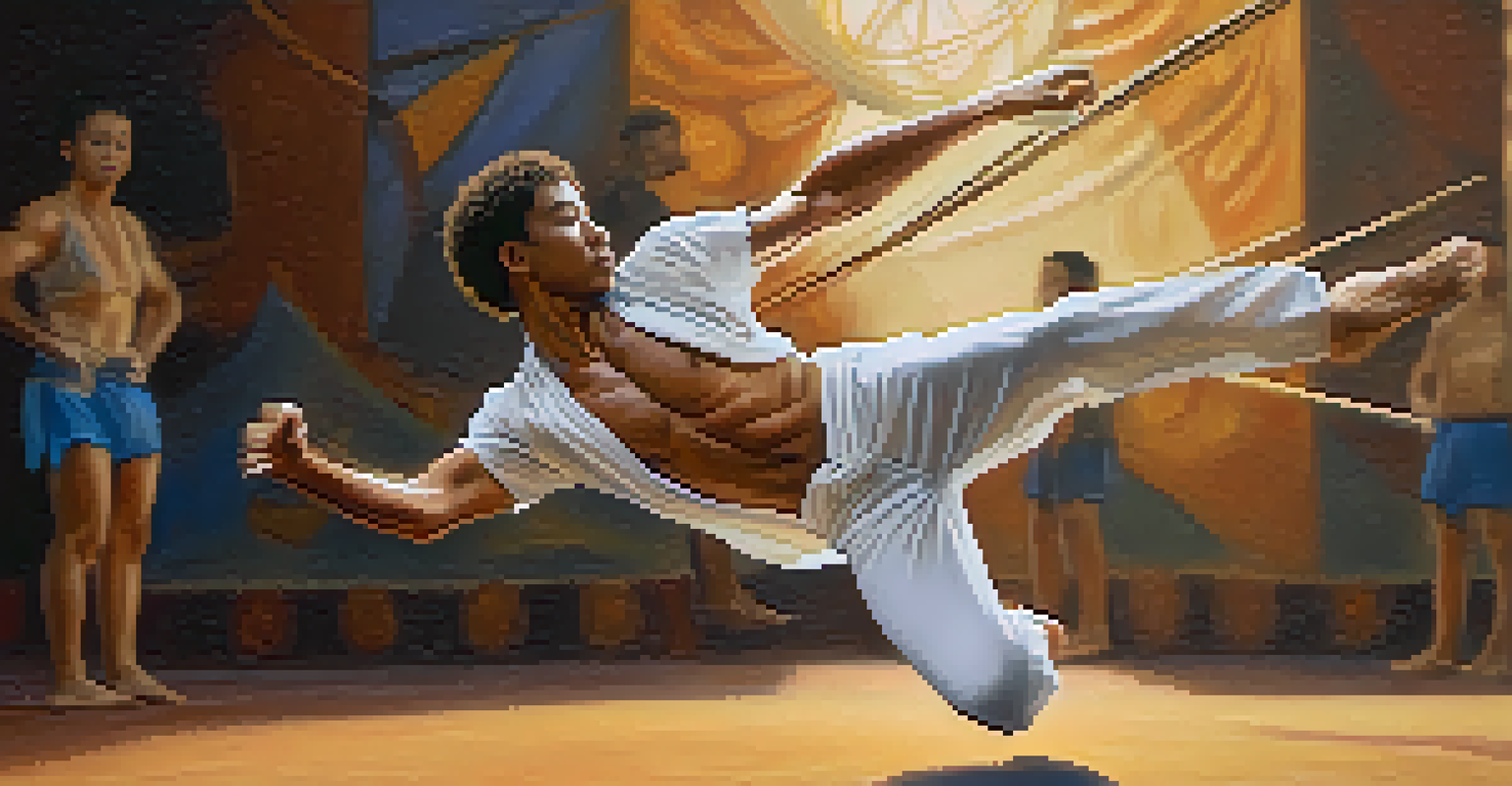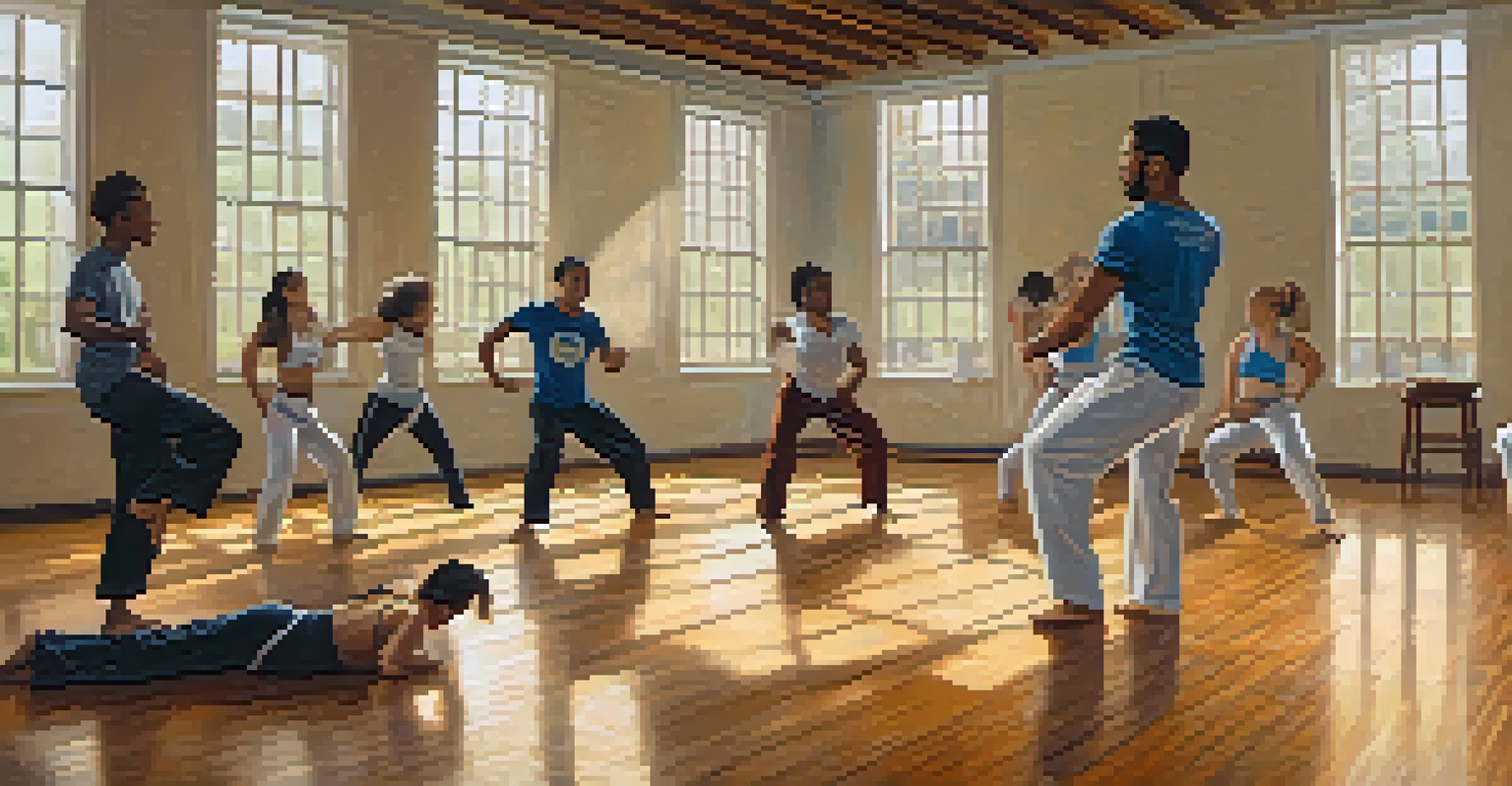Capoeira: The Dance of Fighting and Its Unique Movements

What is Capoeira and Its Origins?
Capoeira is a Brazilian martial art that beautifully blends dance, acrobatics, and music. Its roots trace back to the African slaves in Brazil, who created it as a way to resist oppression while disguising their training as a dance. This unique art form emerged in the 16th century and has evolved over the years, gaining global popularity.
Capoeira is a celebration of life, creativity, and connection with others.
The essence of Capoeira lies not only in its physical movements but also in its cultural significance. It serves as a symbol of resilience and community, reflecting the struggles and triumphs of those who practiced it. Today, it is recognized as an important part of Brazilian heritage and is celebrated worldwide.
Each Capoeira movement, known as a 'ginga,' tells a story and embodies the spirit of freedom. This art form is not just about fighting; it's a celebration of life, creativity, and connection with others, making it a truly unique experience.
Key Movements and Techniques in Capoeira
Capoeira features a variety of dynamic movements, such as kicks, spins, and acrobatics, that make it visually captivating. Techniques like the 'meia-lua' (half-moon kick) and 'au' (cartwheel) showcase the fluidity and agility of practitioners. Each movement is designed to be both offensive and defensive, allowing for a playful exchange between opponents.

One of the most striking aspects of Capoeira is how it incorporates rhythm and music into its practice. The movements are often synchronized with traditional instruments like the berimbau, which sets the tempo and mood of the jogo (game). This connection between movement and music creates an immersive experience that enhances the beauty of the art form.
Capoeira: A Cultural Fusion
Capoeira is a unique Brazilian martial art that combines dance, acrobatics, and music, originating as a form of resistance among African slaves.
Additionally, Capoeira emphasizes adaptability and improvisation. As practitioners engage in a game, they must read their opponent's intentions and respond creatively. This not only keeps the practice exciting but also fosters a strong sense of community, as players often cheer and support each other during their exchanges.
The Role of Music in Capoeira
Music is at the heart of Capoeira, playing a crucial role in setting the atmosphere and guiding the movements. Traditional songs, often sung in Portuguese, tell stories of resistance, love, and the history of the art form. The rhythm generated by instruments like the atabaque and pandeiro fuels the energy of the game, making it an integral part of the experience.
Through Capoeira, we not only honor our roots but also share our stories and experiences.
As players engage in the jogo, they move in harmony with the music, responding to its beats and melodies. This interaction creates a unique synergy that enhances both the physical and emotional aspects of Capoeira. The act of playing together fosters camaraderie and unity among participants, reinforcing the cultural bonds that define Capoeira.
Moreover, learning the songs and rhythms is essential for any Capoeira practitioner. It deepens their understanding of the art form and enriches their connection to its history. This musical foundation allows players to express themselves creatively, adding a personal touch to their practice.
Capoeira as a Form of Self-Expression
Capoeira offers a unique platform for self-expression, allowing individuals to showcase their personality and creativity. Each player brings their own style and flair to the game, making every encounter a distinct experience. This freedom encourages practitioners to explore their movements and engage with their emotions in a supportive environment.
The improvisational nature of Capoeira means that there are no strict rules, enabling players to experiment and invent new movements. This aspect fosters an environment of creativity, where practitioners can build their confidence while expressing their individuality. It's this blend of structure and freedom that makes Capoeira so appealing to many.
Community and Connection in Capoeira
The practice of Capoeira fosters strong community bonds through shared experiences, cultural exchange, and supportive gatherings known as rodas.
Additionally, the cultural context of Capoeira allows practitioners to connect with their heritage. By participating in this art form, individuals not only honor their roots but also share their stories and experiences. This communal aspect enriches the practice, creating a sense of belonging that is vital for personal growth.
Capoeira's Impact on Physical Fitness
Engaging in Capoeira is an excellent way to improve overall fitness while having fun. The dynamic movements combine strength, flexibility, and endurance, making it a comprehensive workout. Practitioners often find themselves building muscle tone and enhancing their cardiovascular health without even realizing it, thanks to the engaging nature of the art form.
Moreover, Capoeira enhances coordination and balance, as players need to move fluidly while maintaining control over their bodies. The diverse range of movements challenges different muscle groups, ensuring a well-rounded physical experience. This focus on agility and body awareness is beneficial not only for Capoeira but also for other physical activities.
Many practitioners also appreciate the mental benefits of Capoeira. The need to think on their feet and adapt to their partner's movements sharpens cognitive skills and boosts confidence. This combination of physical and mental challenges makes Capoeira a rewarding pursuit for individuals of all ages.
Capoeira as a Community Builder
One of the most remarkable aspects of Capoeira is its ability to bring people together. Practitioners often form tight-knit communities, transcending cultural, social, and geographical boundaries. This sense of belonging fosters friendships and creates a support system that enhances the overall experience of learning the art form.
Capoeira events, known as rodas, provide a space for practitioners to gather, share their skills, and celebrate their culture. These gatherings are filled with energy, laughter, and camaraderie, showcasing the vibrant spirit of the Capoeira community. Participants support each other through clapping, singing, and cheering, reinforcing the connections between individuals.
Fitness and Self-Expression
Engaging in Capoeira enhances physical fitness and promotes self-expression, allowing practitioners to explore their creativity while developing strength and agility.
Furthermore, Capoeira serves as a means of cultural exchange, allowing practitioners to learn from one another. As individuals come together from various backgrounds, they share their unique perspectives and experiences, enriching the practice. This exchange not only strengthens the Capoeira community but also fosters global understanding and appreciation for diverse cultures.
Conclusion: The Legacy of Capoeira
Capoeira is more than just a martial art; it is a rich cultural tradition that embodies the spirit of resilience, creativity, and community. Its unique blend of movement, music, and self-expression has captivated individuals around the world, making it a powerful force for personal growth and connection. As more people discover Capoeira, its legacy continues to evolve.
The art form not only celebrates its historical roots but also adapts to contemporary contexts, ensuring its relevance in today's society. By embracing the lessons of Capoeira, practitioners can foster a sense of empowerment and unity, contributing to a more harmonious world.

Ultimately, Capoeira encourages us all to express ourselves, connect with others, and celebrate our shared humanity. As we step into the roda, we join a global family dedicated to preserving and promoting this beautiful dance of fighting.